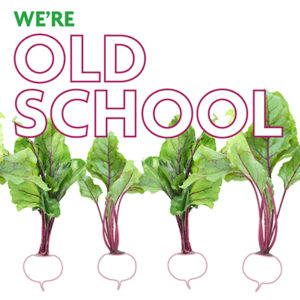
We admit it, there’s no glory in fighting food waste. It’s a battle of minutiae, a day-to-day grind. Planning, paying attention, getting creative with carrot tops and potato peels…
Even so, the truth is, we love it!
Since Bon Appétit Management Company’s founding in 1987 we’ve cooked from scratch, using nose-to-tail and root-to-leaf methods, just like our grandparents used to do. Maybe that makes us old school. But, based on all the home-made kimchi, artisanal bread, and fresh cheese being made by today’s youthful cultural revolutionaries from Williamsburg to rural North Carolina, we think our game is pretty on point.
Going grandma-style by purchasing carefully and upcycling our scraps is important to us, but it’s just the start. Since 2005 we’ve had companywide standards in place to prevent and reduce food waste — way before any other food service company — and since then, our kitchen teams work on perfecting their skills daily in order to be the ultimate Food Waste Warriors.
What does that mean? Well, we’re glad you asked.
As Claire Cummings, our trash-talking waste specialist and Food Waste Warrior Supreme always says: “The best way to address food waste is to stop it from happening in the first place.”
Our groundbreaking Imperfectly Delicious Produce program rescues delicious but cosmetically imperfect, oversized, undersized, and underutilized produce from going to waste on farms and in the supply chain. Maybe you’ve signed up for an “ugly” fruit box, or kept a dog-shaped carrot as a short-term pet (you know who you are) — if so, we’re with you in spirit. Since the program’s start in 2015 we’ve rescued more than 2 million pounds of such misfit fruits and vegetables from going to waste— that’s equivalent to the weight of 240 killer whales or 1.6 million meals — and the program is still expanding.
Being a Warrior means training every day (think of it like a yoga practice, or a marathon). Maybe you’ve weighed your waste during an awareness campaign in your café, or seen signs showing how much plate waste your fellow diners generate. In many of our all-you-care-to-eat cafés we offer trayless dining, which has been proven to reduce plate waste by one third. (Seriously, who throws out a third of their groceries when they walk out of the supermarket? No one. So, why do it in a café? Ponder that one on a training run or during savasana, friend.)
Beyond preventing waste at the source, we believe strongly that food should feed people, not landfills. We were the first food service business to make a commitment to becoming Food Recovery Certified, vowing that by 2018 at least 80 percent of our cafés will be donating their excess food regularly to hunger organizations. We already work with groups across the nation, including Food Runners, Chefs to End Hunger, Food Recovery Network, and Feeding America.
When we can’t rescue food from going to waste in the supply chain, or donate it to hungry people, we still try our hardest to turn it into something useful by donating food scraps to farms for use as animal feed, recycle waste vegetable oil for biofuel, and even use bio-digesters to turn waste into energy when it’s feasible. When we’ve exhausted all of these options, then we compost. Landfills are always our last resort.
Being a Food Waste Warrior means working at it every day, one sun salutation or one mile at a time. But we’re in the fight for the long term, and we hope you’ll join us. For more tips on how to be a Food Waste Warrior at home, visit www.savethefood.com.